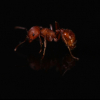- Formiculture.com
- Forums
- Gallery
- Members
- Member Map
- Chat

Mixed Pheidole Colony?
Started By
cpman
, Apr 28 2015 4:21 PM
10 replies to this topic
#1
 Offline
-
Posted April 28 2015 - 4:21 PM
Offline
-
Posted April 28 2015 - 4:21 PM
Hi everyone. Because it is freakishly cold today (60! -- it was over 80 yesterday!), I decided to look at some ants while the cold was keepig them slower. I found two really odd Pheidole colonies. Most of the Pheidole I find are a large, aggressive species in the P. fallax-group. Their majors are around 3-4 mm with a light colored head and mesosoma.
The two colonies I found today were really odd, because in addition to no majors and minors that look like the most common species around here, there were some pure black, shiny majors that were about 1/2 mm smaller than the typical ones. What could they be doing in there? They cooperated amicably with the main Pheidole, moving brood. Their head shape was the same. The majors with light colored heads weren't shiny at all.
Could this be some sort of facultative social parasitism or something else?
I have a low-quality picture that I could post if need be...
Thanks!
The two colonies I found today were really odd, because in addition to no majors and minors that look like the most common species around here, there were some pure black, shiny majors that were about 1/2 mm smaller than the typical ones. What could they be doing in there? They cooperated amicably with the main Pheidole, moving brood. Their head shape was the same. The majors with light colored heads weren't shiny at all.
Could this be some sort of facultative social parasitism or something else?
I have a low-quality picture that I could post if need be...
Thanks!
- Jonathan21700 and AntTeen804 like this
#2
 Online
-
Posted April 29 2015 - 12:39 PM
Online
-
Posted April 29 2015 - 12:39 PM
That's pretty weird. I would love to see pictures of it.
#3
 Offline
-
Posted April 29 2015 - 7:48 PM
Offline
-
Posted April 29 2015 - 7:48 PM
Parasitism?
- Jonathan21700 likes this
#4
 Offline
-
Posted May 5 2015 - 4:33 PM
Offline
-
Posted May 5 2015 - 4:33 PM
Here is a poor quality picture. You can see both types of majors in it. I'll try to collect some specimens of each later to get photos of:


#5
 Online
-
Posted May 5 2015 - 4:53 PM
Online
-
Posted May 5 2015 - 4:53 PM
That's pretty strange.
#6
 Offline
-
Posted May 5 2015 - 6:09 PM
Offline
-
Posted May 5 2015 - 6:09 PM
Very interesting. It could be a species with a trimorphic worker caste. This would explain the unusual size variation. The difference in coloration could simply be explained by age differences.
Edited by Myrmicinae, May 5 2015 - 6:12 PM.
#7
 Offline
-
Posted May 5 2015 - 6:10 PM
Offline
-
Posted May 5 2015 - 6:10 PM
Maybe they just eclosed.
#8
 Online
-
Posted May 5 2015 - 7:30 PM
Online
-
Posted May 5 2015 - 7:30 PM
Maybe they just eclosed.
I was wondering if that could be it.
#9
 Offline
-
Posted May 6 2015 - 3:20 PM
Offline
-
Posted May 6 2015 - 3:20 PM
I'll try to grab a few of each type of major. I think they could have stolen pupae from another Pheidole for food, and forgot to eat them all. I just hope neither colony I found like this has moved due to the 5" of rain we got yesterday...
#10
 Online
-
Posted May 6 2015 - 4:28 PM
Online
-
Posted May 6 2015 - 4:28 PM
I think they could have stolen pupae from another Pheidole for food, and forgot to eat them all.
![]()
#11
 Offline
-
Posted May 7 2015 - 10:32 PM
Offline
-
Posted May 7 2015 - 10:32 PM
Any parasitic mites? I know that if a callow worker gets mites then it stays lightly colored for the whole time it has the mites.
- Jonathan21700 likes this
0 user(s) are reading this topic
0 members, 0 guests, 0 anonymous users
















